Stock transfer in SAP play a crucial role in effective inventory management by enabling the seamless movement of goods between storage locations, plants, or even company codes.
Whether we are transferring stock within the same plant, across different plants, or between different organizational units, SAP stock transfer solutions like 1-step and 2-step transfers, offers flexible and robust solutions to manage these transactions efficiently.
Table of Contents
1. Stock Transfer in SAP: All Scenarios at a Glance
SAP provides multiple stock transfer methods, including one-step and two-step transfers, stock transport orders (STO), and intercompany transfers, each catering to specific business needs.
Understanding these processes helps businesses optimize supply chain operations, reduce costs, and ensure compliance.
Stock transfer in SAP can be classified into two types from a broader prospective. These can be further divided into several other types.
Please see below this in pictorial form
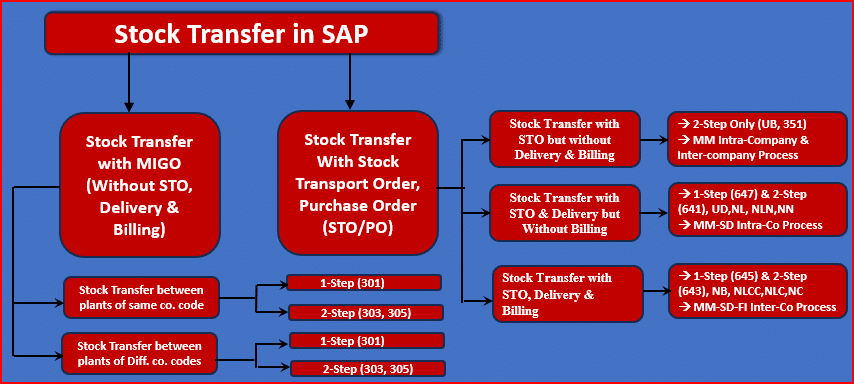
1.1 Stock Transfer with MIGO (Without STO, Delivery & Billing)
This is the simplest form of stock transfer in SAP.
In this scenario, no stock transfer order or purchase order is created.
Stock transfer is directly initiated in MIGO without any predecessor document like STO or PO.
This stock transfer process can be further bifurcated into two
- Stock Transfer between plants of same company code
- Stock Transfer between plants of Different company codes
Both the above two types can be executed in 1-step or 2-step process.
We will look into these in detail in the later section
Please see below these types of stock transfer in pictorial form.
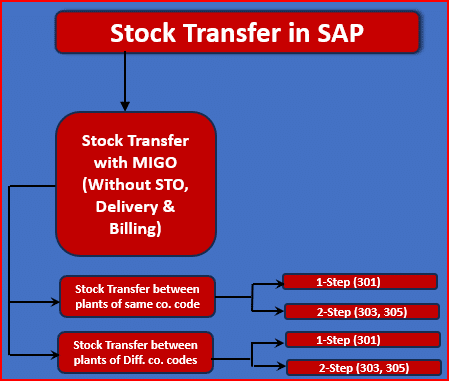
These types of stock transfers offer a more simplified method, primarily suited for intra-company movements or specific organizational needs
--> This stock transfer method optimize the logistics processes and eliminate some administrative overheads.
--> This method of stock transfer refers to directly moving materials between storage locations or plants without creating a purchase order or transport order.
--> This is often beneficial in cases of internal transfers where financial and logistical documentation requirements are minimal.
1.1.1 Advantages of Stock Transfer with MIGO
Below are the advantages of Stock Transfer with MIGO i.e. without STO, Delivery & Billing
a) Cost Efficiency:
Stock Transfer without STO, Delivery & Billing eliminates administrative costs associated with creating and managing transport orders and deliveries.
b) Speed
Stock Transfer without STO, Delivery & Billing accelerates the stock movement process by avoiding complex & long order creation steps.
c) Simplified Process
Stock Transfer without STO, Delivery & Billing is Ideal for companies with frequent internal stock movement. It reduces paperwork and processing time.
1.1.2 Business Scenarios of Stock Transfer with MIGO
Below are the possible business scenarios of Stock Transfer with MIGO i.e. without STO, Delivery & Billing
a) Internal Stock Rebalancing
Stock Transfer without STO, Delivery & Billing comes handy, When warehouses or plants need to balance inventory across locations.
b) Emergency Stock Transfer
Stock Transfer without STO, Delivery & Billing caters well where Immediate stock movement required for production needs without the need for extensive documentation.
c) Supply Chain Improvement
Since this process optimize stock transfers without using stock transport orders, businesses can streamline operations, reduce overhead costs, and improve supply chain responsiveness.
Before looking into execution of stock transfer we will check what is inter-company stock transfer & intra-company Stock Transfer
1.1.3 Inter-Company & Intra-Company Stock Transfer
A large company having plants in different locations needs to move the material between it’s plants. For example We have two plants on our car business PA10 & PA20.
Plant PA10 produces engines and plant PA20 assembles the car using the engines produced in plant PA10. So to transfer the engines from the plant PA10 to PA20 we will use STO (Stock Transport Order) in SAP
--> Now in the above example if plants PA10 & PA20 belongs to same company code (No need of having separate legal accounts etc.) then it will be an example of intracompany STO.
--> If Plant PA10 & PA20 belongs to different company code (to have separate legal accounts etc.) then it will be an example of intercompany STO.
For our car business we have two companies and three plants as shown in the below picture

- The STO between plants PA10 & PA20 (Both belongs to Company Code PA10) will be a intra-company STO).
- The STO between plants PA10/PA20 (Both belongs to Company Code PA10) & PP10 (Belongs to company code PP10) will be a intercompany STO).
1.1.4 Execution of Stock Transfer with MIGO
There are further 4 scenarios related to the Stock Transfer without STO, Delivery & Billing
- One Step Stock Transfer Between Plants of same Company Code
- Two Step Stock Transfer Between Plants of same Company Code
- One Step Stock Transfer Between Plants of different Company Code
- Two Step Stock Transfer Between Plants of Different Company Codes
a) One Step Stock Transfer Between Plants of same Company Code
In One Step Stock Transfer Between Plants stock is issued from the issuing plant & received in receiving plant in 1 step.
This process uses movement type 301
Start MIGO and choose transaction as “A08 – Transfer Posting” & movement type as “301”
input source plant as “PA10” & destination plant as “PA20”. Both these plants belongs to the same company code.
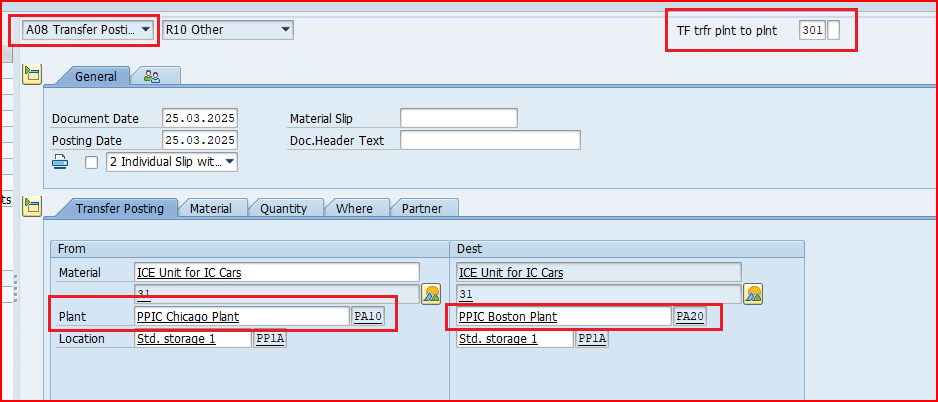
Check & post. Material document & FI documents are posted.
Note: Please check the below posts to see the configuration of organization structure i.e. company codes, plants etc.
Configure SAP Finance Organization Structure in 5 Minutes
Configure SAP S4 HANA Material Management Organization Structure in 5 Minutes
b) Two Step Stock Transfer Between Plants of same Company Code
In two Step Stock Transfer Between Plants stock is issued from the issuing plant & received in receiving plant in 2 steps.
As the name suggests , this stock transfer is executed in the two steps.
First step removes the stock from the sending plant and post the material into transit.
The second steps place the stock in the receiving plant stock.
We will see the details of both these steps one by one
b1) First Step- Removal of the Stock from the Sending plant
This process uses movement type 303 (Transfer posting plant to plant – remove from storage).
Start MIGO and choose transaction as “A08 – Transfer Posting” & movement type as “303”
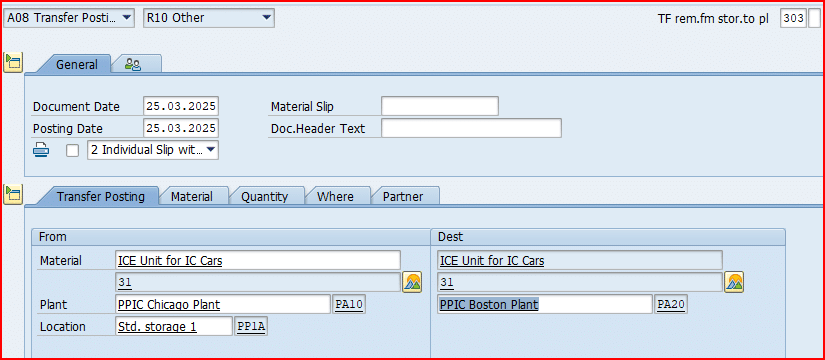
check and post. Material document number 4900000218 is posted.
b2) Second Step- Receipt of the stock into the Receiving Plant
This process uses movement type 305 (Transfer posting plant to plant – place in storage).
Start MIGO and choose transaction as “A10 – Place in Storage” again material document “4900000218” created in first step.

--> In the second Step of Receipt of the stock into the Receiving Plant, no accounting document is posted.
c) One Step Stock Transfer Between Plants of different Company Code
Here stock is transferred In One Step between sending plant & receiving plant which belongs to the different company codes.
This process uses movement type 301 same as One Step Stock Transfer Between Plants of same Company Code
Start MIGO and choose transaction as “A08 – Transfer Posting” & movement type as “301”
input source plant as “PA10” & destination plant as “PP10”. Both these plants belongs to the different company codes.
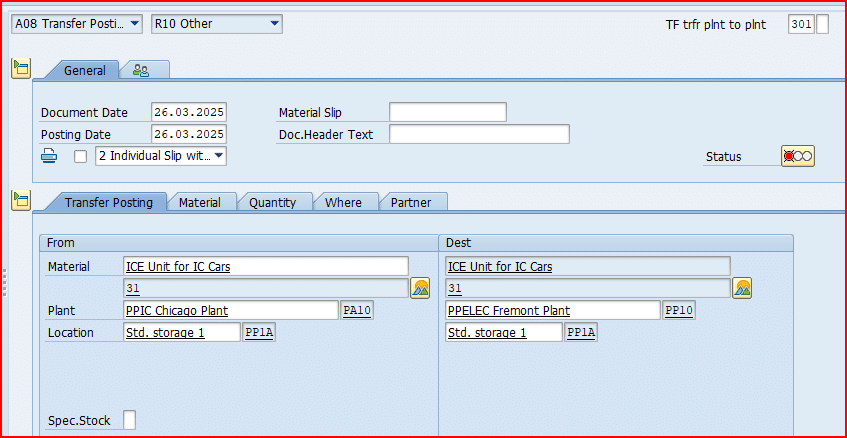
System is throwing clearing accounts error

Check & post. Material document & FI documents are posted.
to maintain the clearing account start OBYA
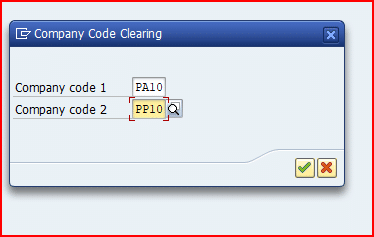
Now maintain the clearing account as below
- Debit -116014100 (PPIN-Clearing Account for Asset Acquisition)
- Credit- 770030000 (PPIN-Clearing Account Asset Disposals)
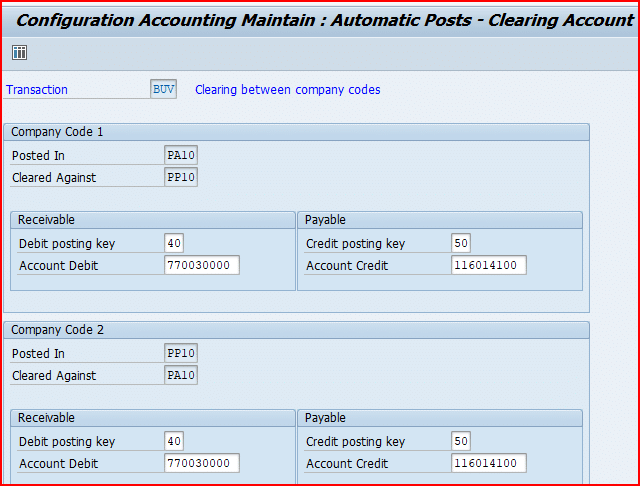
Transaction is posted successfully. Material document & FI document is created
FI document posted in the sending company code
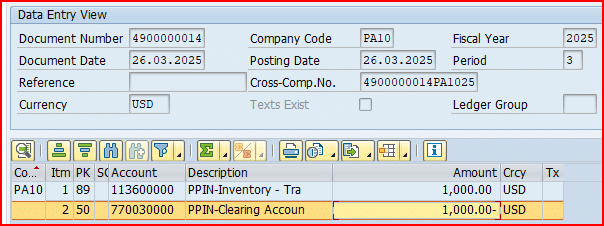
FI document posted in the Receiving company code
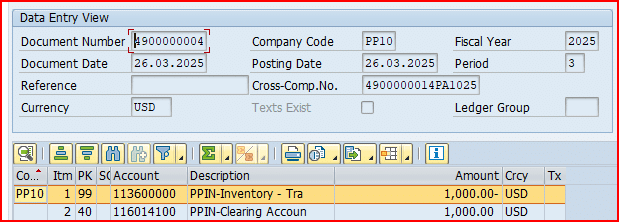
d) Two Step Stock Transfer Between Plants of Different Company Codes
In two Step Stock Transfer Between Plants of different company codes, stock is issued from the issuing plant & received in receiving plant in two step.
As the name suggests , this stock transfer is executed in the two steps.
First step removes the stock from the sending plant from the first company code and post the material into transit.
The second steps place the stock in the receiving plant stock of another company code.
We will see the details of both these steps.
d1) First Step- Removal of the Stock from the Sending plant
This process uses movement type 303 (Transfer posting plant to plant – remove from storage).
Start MIGO and choose transaction as “A08 – Transfer Posting” & movement type as “303”
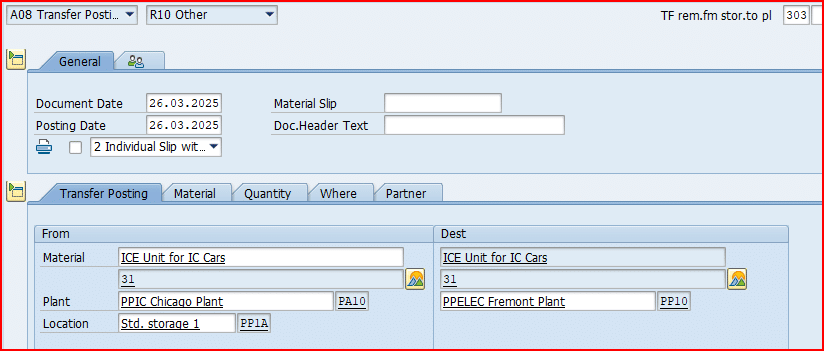
check and post. Material document number 4900000218 is posted.
--> Accounting entries for the two step stock transfer will be exactly same as one step stock transfer.
d2) Second Step- Receipt of the stock into the Receiving Plant
This process uses movement type 305 (Transfer posting plant to plant – place in storage).
Start MIGO and choose transaction as “A10 – Place in Storage” against the material document generated in the first step.
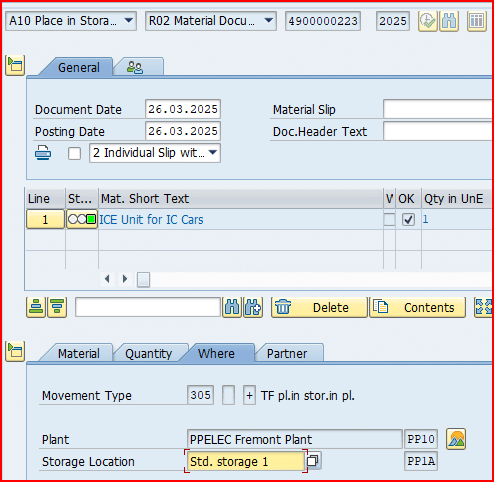
--> No accounting document is posted in the second Step of the receipt of the stock into the Receiving Plant,
1.2 Stock Transfer With Stock Transport Order/Purchase Order (STO/PO)
Here stock transfer process starts with a document i.e. stock transport order, which is a kind of purchase order.
There are several types of Stock Transfer With Stock Transport Order/Purchase Order (STO/PO)
All types of Stock Transfer With Stock Transport Order/Purchase Order (STO/PO) is given below in pictorial form
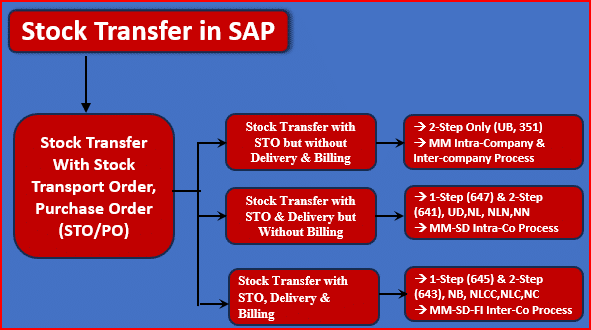
Please continue with the below post for all the step by step details of Stock Transfer With Stock Transport Order/Purchase Order (STO/PO).







